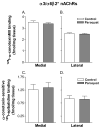Paraquat exposure reduces nicotinic receptor-evoked dopamine release in monkey striatum
- PMID: 18606871
- PMCID: PMC2657317
- DOI: 10.1124/jpet.108.141861
Paraquat exposure reduces nicotinic receptor-evoked dopamine release in monkey striatum
Abstract
Paraquat, an herbicide widely used in the agricultural industry, has been associated with lung, liver, and kidney toxicity in humans. In addition, it is linked to an increased risk of Parkinson's disease. For this reason, we had previously investigated the effects of paraquat in mice and showed that it influenced striatal nicotinic receptor (nAChR) expression but not nAChR-mediated dopaminergic function. Because nonhuman primates are evolutionarily closer to humans and may better model the effects of pesticide exposure in man, we examined the effects of paraquat on striatal nAChR function and expression in monkeys. Monkeys were administered saline or paraquat once weekly for 6 weeks, after which nAChR levels and receptor-evoked [(3)H]dopamine ([(3)H]DA) release were measured in the striatum. The functional studies showed that paraquat exposure attenuated dopamine (DA) release evoked by alpha3/alpha6beta2(*) (nAChR that is composed of the alpha3 or alpha6 subunits, and beta2; the asterisk indicates the possible presence of additional subunits) nAChRs, a subtype present only on striatal dopaminergic terminals, with no decline in release mediated by alpha4beta2(*) (nAChR containing alpha4 and beta2 subunits, but not alpha3 or alpha6) nAChRs, present on both DA terminals and striatal neurons. Paraquat treatment decreased alpha4beta2(*) but not alpha3/alpha6beta2(*) nAChR expression. The differential effects of paraquat on nAChR expression and receptor-evoked [(3)H]DA release emphasize the importance of evaluating changes in functional measures. The finding that paraquat treatment has a negative impact on striatal nAChR-mediated dopaminergic activity in monkeys but not mice indicates the need for determining the effects of pesticides in higher species.
Figures




References
-
- Alexander GM, Schwartzman RJ, Brainard L, Gordon SW, Grothusen JR. Changes in brain catecholamines and dopamine uptake sites at different stages of MPTP parkinsonism in monkeys. Brain Res. 1992;588:261–269. - PubMed
-
- Di Monte DA. The environment and Parkinson’s disease: is the nigrostriatal system preferentially targeted by neurotoxins? Lancet Neurol. 2003;2:531–538. - PubMed
Publication types
MeSH terms
Substances
Grants and funding
LinkOut - more resources
Full Text Sources

